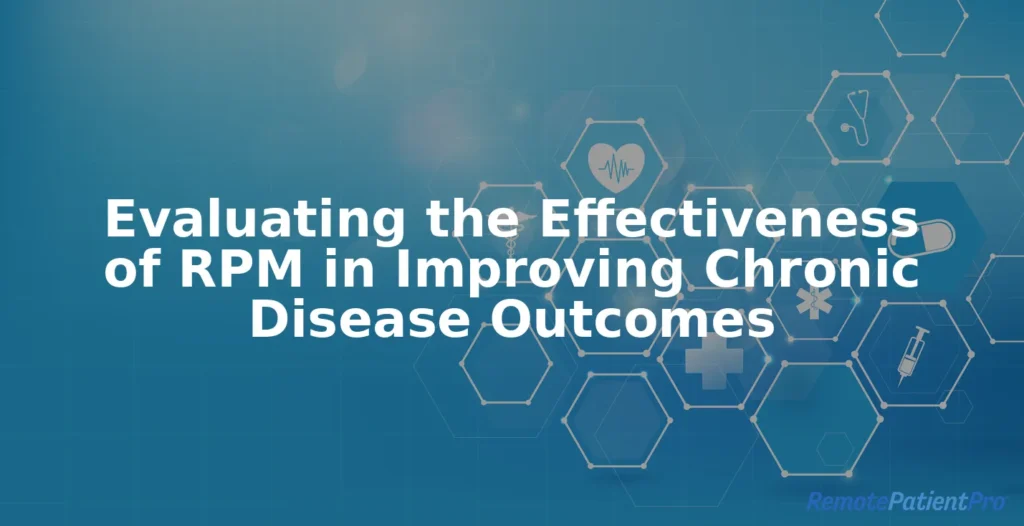Evaluating the Effectiveness of RPM in Improving Chronic Disease Outcomes
Remote patient monitoring (RPM) is transforming chronic disease management by providing real-time health data and enabling proactive care. While RPM holds immense potential, evaluating its effectiveness is crucial to ensure it delivers on its promises of improved outcomes, reduced costs, and enhanced patient satisfaction. At TriageLogic, we provide tools and strategies for evaluating the effectiveness of RPM in improving chronic disease outcomes.
Why Evaluate RPM Effectiveness?
- Measure Patient Outcomes
Understand how RPM contributes to improved health metrics such as blood pressure, glucose levels, and weight management. - Optimize Program Performance
Identify areas for improvement to ensure your RPM program delivers the best results. - Enhance Patient Engagement
Evaluate how patients are using RPM devices and responding to feedback. - Support Reimbursement and Compliance
Demonstrate the value of your RPM program to insurers and meet regulatory requirements. - Drive Cost-Effectiveness
Assess the financial impact of RPM by calculating cost savings from reduced hospitalizations and emergency visits.
The Bipartisan Policy Center discusses strategies to maximize the effectiveness of RPM.
Key Metrics for Evaluating RPM Effectiveness
1. Clinical Outcomes
- Improvements in chronic disease markers such as blood pressure, glucose levels, and oxygen saturation.
- Reduction in hospital readmissions and emergency visits.
2. Patient Engagement
- Frequency of RPM device usage.
- Patient adherence to prescribed monitoring routines and care plans.
3. Provider Efficiency
- Reduction in administrative tasks through automated data collection and reporting.
- Time savings for providers managing large patient populations.
4. Patient Satisfaction
- Feedback from patients on their experience with RPM tools and care delivery.
- Improvement in patient-reported health outcomes and quality of life.
5. Financial Impact
- Cost savings from fewer hospitalizations and in-person visits.
- Revenue generated through Medicare and insurance reimbursements.
Steps to Evaluate RPM Effectiveness
1. Set Clear Goals
- Define measurable objectives for your RPM program, such as reducing hospital readmissions by 20% or achieving 90% patient adherence.
2. Collect and Analyze Data
- Use RPM platforms to track key metrics like vital signs, patient engagement, and alerts.
- Leverage analytics tools to identify trends and insights.
3. Monitor Patient Feedback
- Conduct surveys to understand patient satisfaction and identify areas for improvement.
4. Compare Outcomes with Benchmarks
- Evaluate your program’s results against industry standards or previous internal data.
5. Adjust and Improve
- Use insights from your evaluation to refine your RPM program, such as introducing new devices or adjusting patient communication strategies.
6. Report Results
- Share findings with stakeholders, including providers, patients, and insurers, to demonstrate the program’s value.
Challenges in Evaluating RPM Effectiveness and Solutions
1. Limited Data Collection
- Solution: Use RPM platforms with robust data collection and analytics features to gather comprehensive insights.
2. Patient Non-Adherence
- Solution: Provide education and support to improve patient engagement and adherence.
3. Difficulty Measuring Financial Impact
- Solution: Track costs and savings over time, focusing on metrics like reduced hospitalizations and Medicare reimbursements.
4. Integration Issues
- Solution: Choose RPM tools that seamlessly integrate with your existing EHR system for easier data analysis.
Benefits of Evaluating RPM Effectiveness
- Improved Health Outcomes
Evaluation helps identify what works, leading to better patient results. - Enhanced Program Efficiency
Insights from evaluation streamline workflows and improve resource allocation. - Increased Patient Satisfaction
Continuous improvements ensure patients feel supported and valued. - Stronger Financial Case
Demonstrating cost-effectiveness supports continued investment in RPM programs. - Regulatory Compliance
Evaluation ensures that RPM programs meet industry standards and reimbursement criteria.
Learn more about the impact of RPM on chronic disease management from the Centers for Disease Control and Prevention (CDC).
How RemotePatientPro™ Supports RPM Evaluation
TriageLogic’s RemotePatientPro includes tools and guidance to help healthcare providers evaluate their RPM programs effectively.
- Comprehensive Analytics Tools: Track key metrics like clinical outcomes, patient engagement, and financial impact.
- Survey and Feedback Platforms: Collect patient and provider insights to refine your program.
- Integration Support: Ensure seamless data collection and analysis with EHR systems.
- Ongoing Assistance: Receive continuous support to improve your RPM program based on evaluation findings.
Frequently Asked Questions
Q: What metrics should I focus on when evaluating RPM effectiveness?
A: Key metrics include clinical outcomes, patient engagement, provider efficiency, patient satisfaction, and financial impact.
Q: How often should I evaluate my RPM program?
A: Regular evaluations, such as quarterly or biannually, ensure your program remains effective and aligned with goals.
Q: How does RemotePatientPro assist with RPM evaluation?
A: We provide analytics tools, feedback platforms, and expert guidance to help you assess and optimize your program.
Optimize Your RPM Program for Chronic Disease Management
Evaluating the effectiveness of your RPM program is essential to ensuring its success. By focusing on key metrics and making data-driven improvements, you can enhance patient outcomes, streamline workflows, and maximize cost savings. At TriageLogic, we’re here to help you achieve these goals.
Contact us today to learn more about our RPM solutions and evaluation support.

